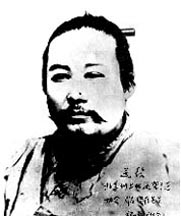|
|
Excerpts from " The Secrets of Uechi Ryu Karate and The Mysteries of Okinawa"
|
|
As least two different backgrounds have been established
for Shushiwa. The same is true for the art of Pangainoon
which he taught to Kanbun Uechi in the latter part of the
19th century. Shushiwa, described as an intelligent and dedicated
student, became proficient in several forms of Chinese
boxing, particularly Tiger Fist, one of the Five Fists of
Fujian. Legends attribute him with great strength. He
reportedly could hold the weight of two people hanging from
the fingertips of his outstretched arms. He also became an
accomplished painter and calligrapher. Shushiwa contracted a severe illness and died in 1926, at
the young age of fifty-two.


|
|
|
|
|
|